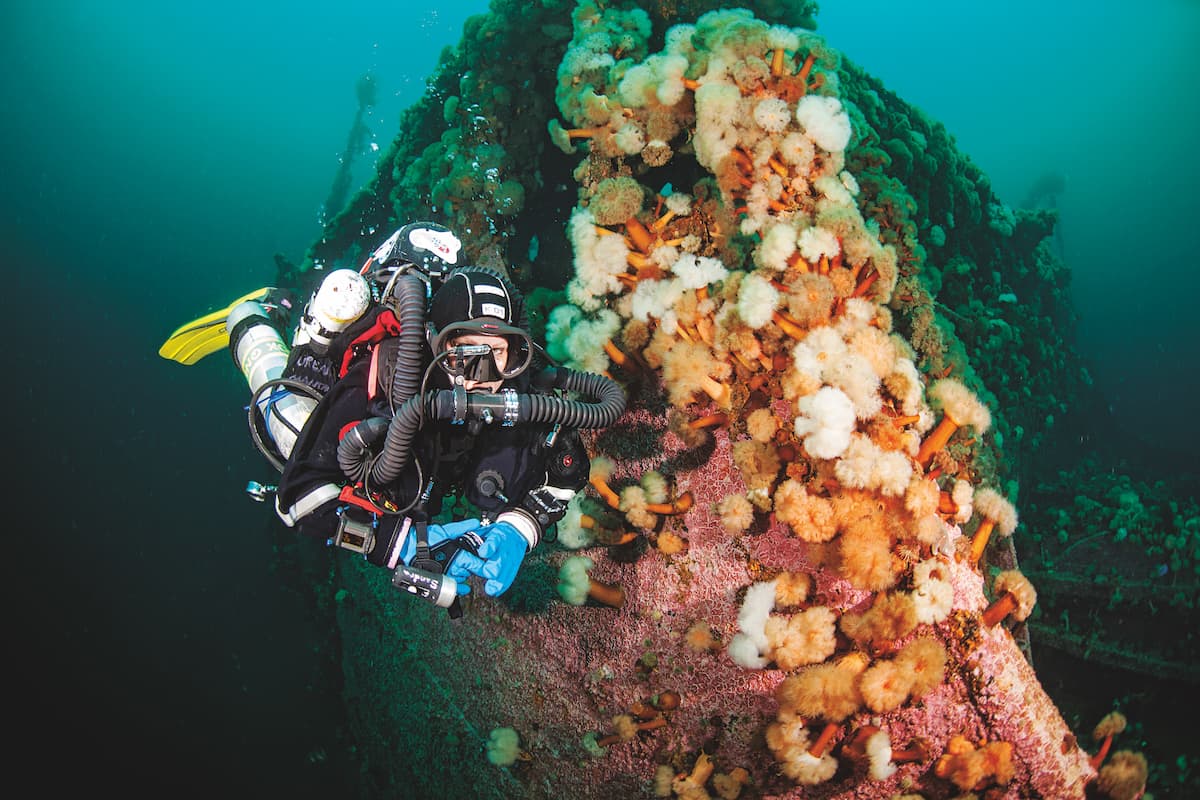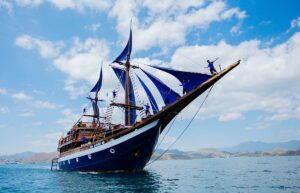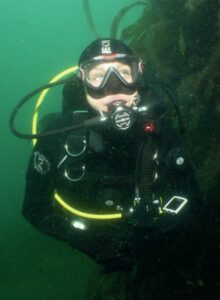Photographs by Jill Heinerth
In the pale light of a wintery Canadian dawn, the Arctic blast persuades me to snug my hat securely down over my ears. Emerging from the neck of my parka, my muffled voice emits curly wisps of white vapor into the cold air. A barrel-chested John Olivero vaults clear of his truck in a long-sleeved T-shirt loudly announcing ‘let's go diving!’ My sturdy Canadian resolve cannot hide my disbelief.
“First, we have to get out of the driveway, Johnny!” I mumble
“No problem!” he smiles backs. “We have a secret weapon!”
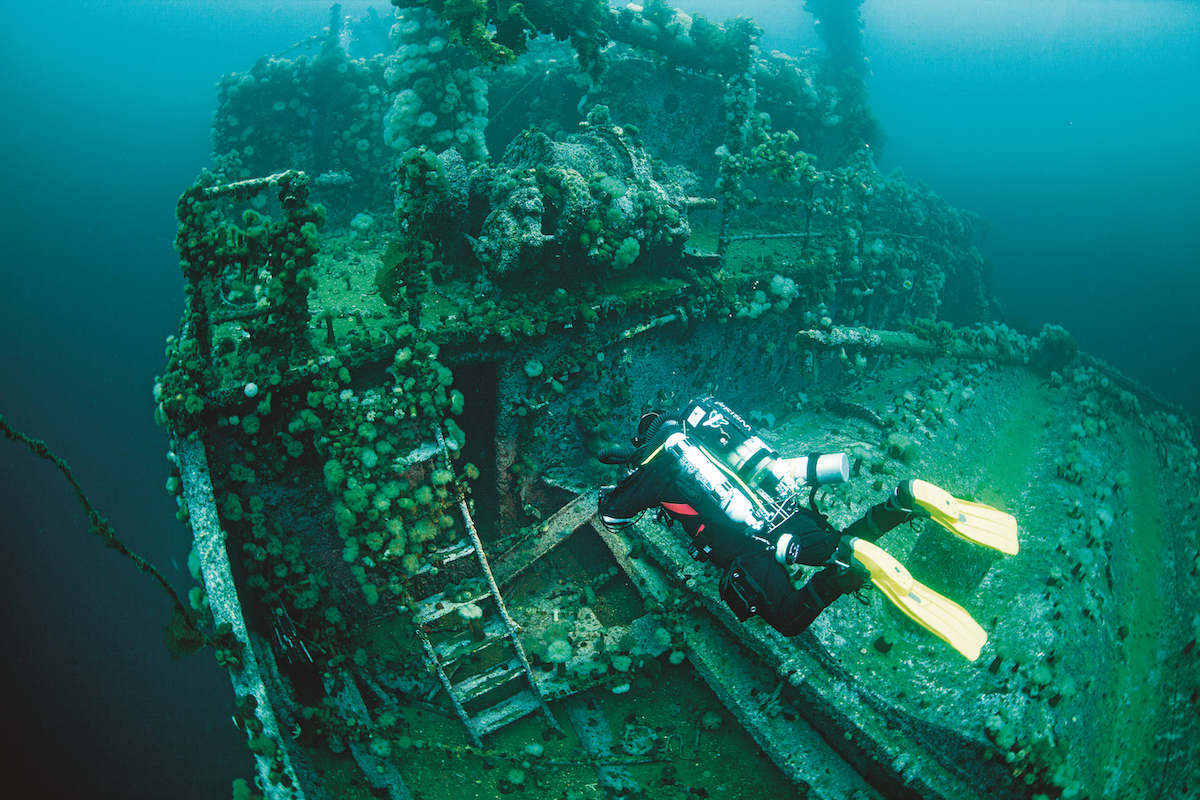
Who would have imagined that a diving expedition would require a snowplow? On this day, we need it to move the three-feet-deep snow that has accumulated overnight. But the list of necessary tools is even more peculiar. For months, John Olivero and Ocean Quest Adventure Resort owner Rick Stanley wrangled volunteers, convincing them to heft pickaxes and shovels to prepare for our visit.
The group of selfless volunteers moved tons of iron ore, built decks and benches, and installed critical lighting in preparation for us to dive into the depths of the Bell Island Mine. February never deterred their dedication. On the contrary, there is plenty of time in the winter for projects and diversions. In Newfoundland, summertime is an orgy of outdoor activity – 18-hour days crowded with whales, World War Two wrecks, beach picnics and icebergs, leaving little room for manual labor. Winter is work time. Summer is for play.
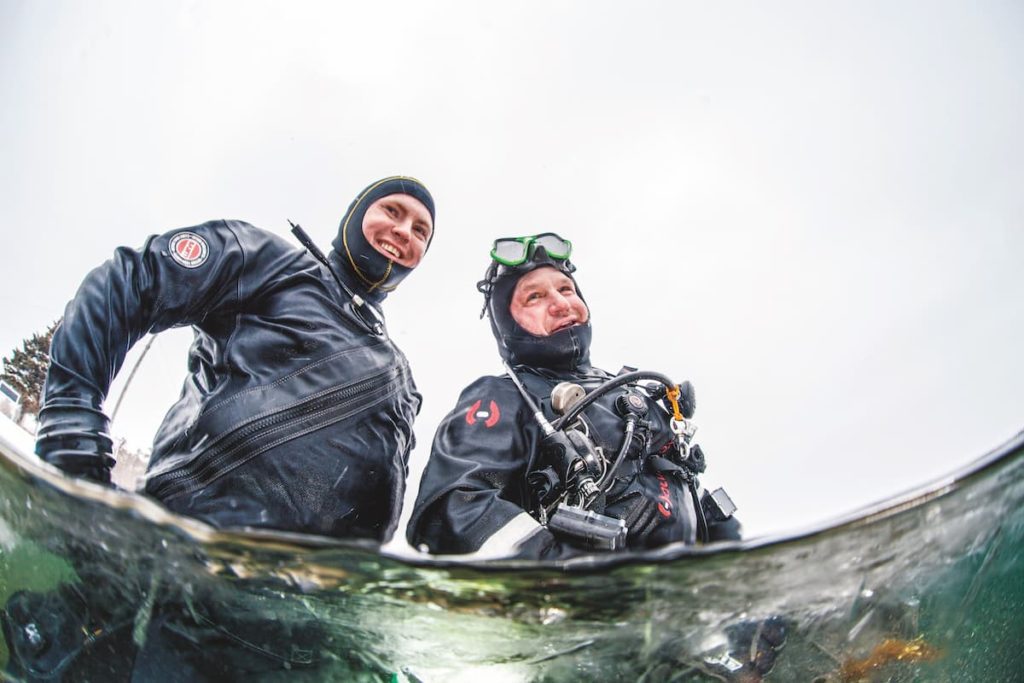
Diving Newfoundland – A Historic Hidden Gem
Most vacationers to this area don’t visit in February, but choose instead to enjoy the summertime. Newfoundland might not the first name that comes to mind when planning a vacation. North America’s easternmost point balances on the verge of Canada’s Atlantic frontier like a launching springboard diver rising from his toes into an aerial pike to be free of the continent. The vibe of this place is inspiring – strong, homey, and a little bit quirky. Living life in extremes breeds a true sense of community. You can’t leave this place a stranger because a new family will have captivated your heart.
I first visited Newfoundland by bicycle after making a 4,350-mile ride across Canada. When I met the genial Rick Stanley, I knew I had to go back to tell the story of its hidden geography. Flooded iron mines cover nine square miles and descend over 1,800 feet beneath Bell Island. Historic shipwrecks lay just offshore. The mines were once the area’s economic engine providing extremely high-grade iron ore to shipbuilding efforts in the Great Wars. Recognizing the strategic importance of the mines, German U-boats twice raided the island in 1942. The Germans knew that if they could disrupt the export of shipbuilding materials, even temporarily, then the Allied war efforts would be seriously affected.
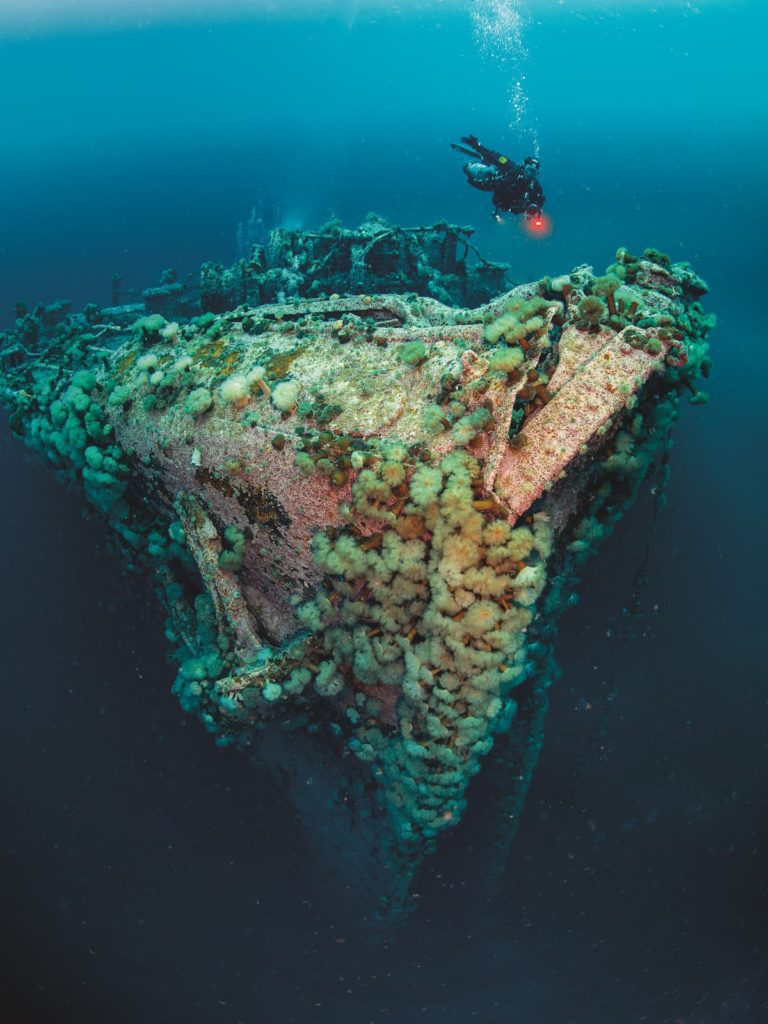
In two separate attacks, German submariners sunk the vessels SS Saganaga and SS Lord Strathcona, followed by the SS Rose Castle, and Free French vessel PLM 27, while destroying the ore-loading wharf on Bell Island. The sheer audacity of the attack awakened North Americans that they were now on the front line for the Battle of the Atlantic.
Part of the mine closed not long after World War Two due to a decline in the ore market value, but the economic hammer slammed down hard over the Christmas Holidays in 1966. When miners returned to work in January, they discovered that the mine was full of water. Determining that extraction was no longer feasible, owners had pulled the plug on the dewatering pumps and let the network of tunnels slowly fill, leaving the entire island in jobless despair.
The remaining dry sections of Bell Island collected cobwebs until a modest museum opened up at the No. 2 Mine entrance. Offering walking tours of the first 650 feet down to the water line, guides keep their family histories alive by telling (and even singing) stories about over 100 men that died in the course of their work there.
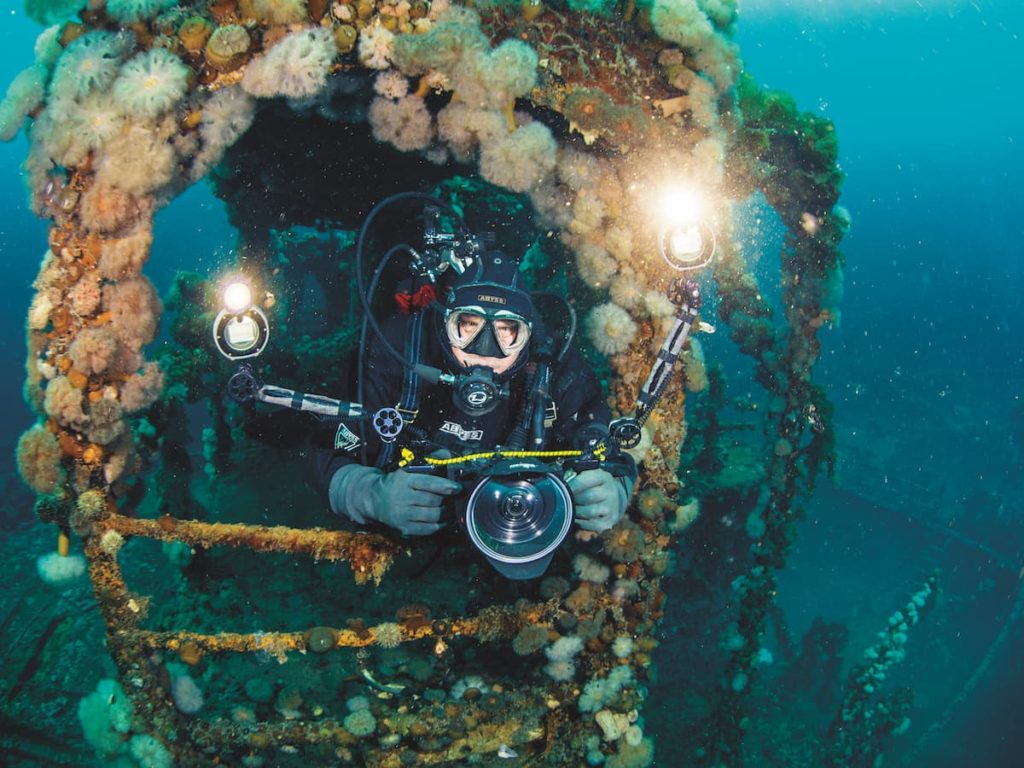
Newfoundland’s Fascinating Mines
Squared off walls marked with large white numerals enumerate every crossing rib in this maze of hematite ore, that descends one foot for every body length we swim. Nearly 16 feet above the floor, electrical wiring with bright turquoise insulators and wooden crossbars lead us on a trail toward some of the heavy machinery that once kept this place dry. A crumpled bucket, pair of old leather shoes, broken shovels, and saws make it seem as if the site is frozen in time. What remains is a time capsule conserving the demoralizing moment of economic desperation when the pumps were turned off.
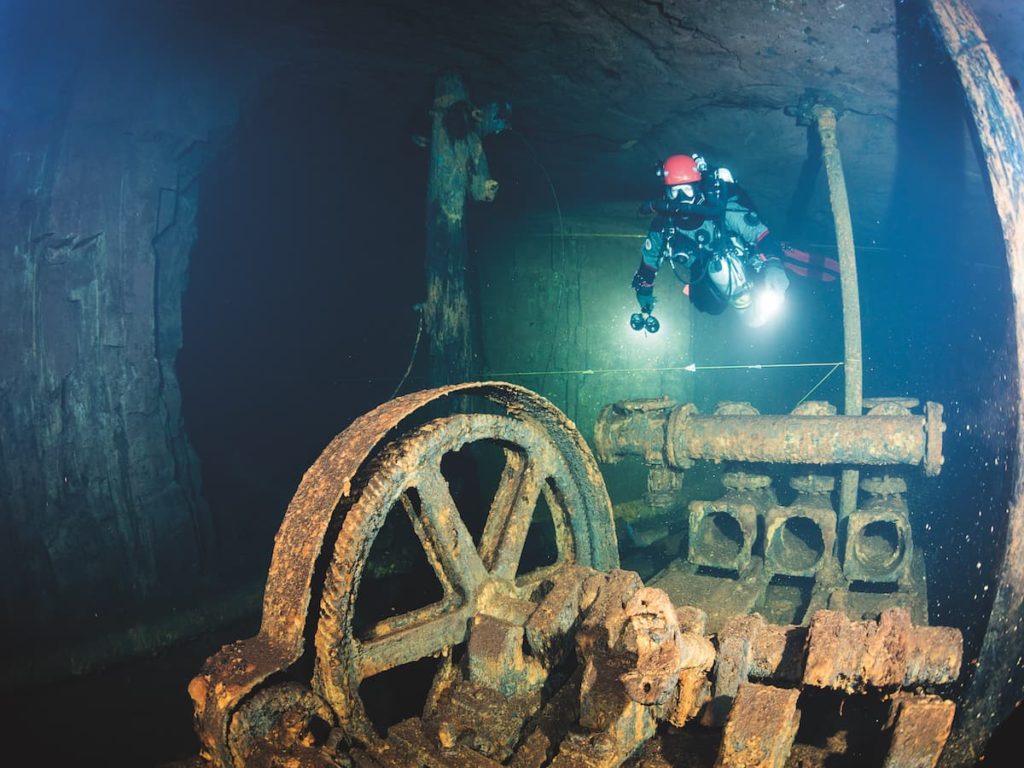
Gliding over the chassis from an ore cart, we reach a large dewatering pump. A hulking crippled wheel connects long silent gears with broken pistons that supply severed pipelines. An inscription on the wall catches our attention. ‘James Bennett’ has scrawled his name beside a cartoonish caricature sporting a small pipe and watchman’s cap.
I envision this man taking a smoke break in the dank dust-filled darkness. A nearby tangle of rusty box springs may be evidence that he took a few covert naps as well. Around the next corner is an epitaph.
A tiny white cross adorns the wall in a place where a miner has lost his life. Was it a fall of rock, or was he run over by a cart racing through the darkness on this now-empty track? It was a tough business, and not a single family was spared tragedy. If you didn’t lose a loved one in the mine, you might have a family tale about the nights that torpedoes brought the war to your doorstep.
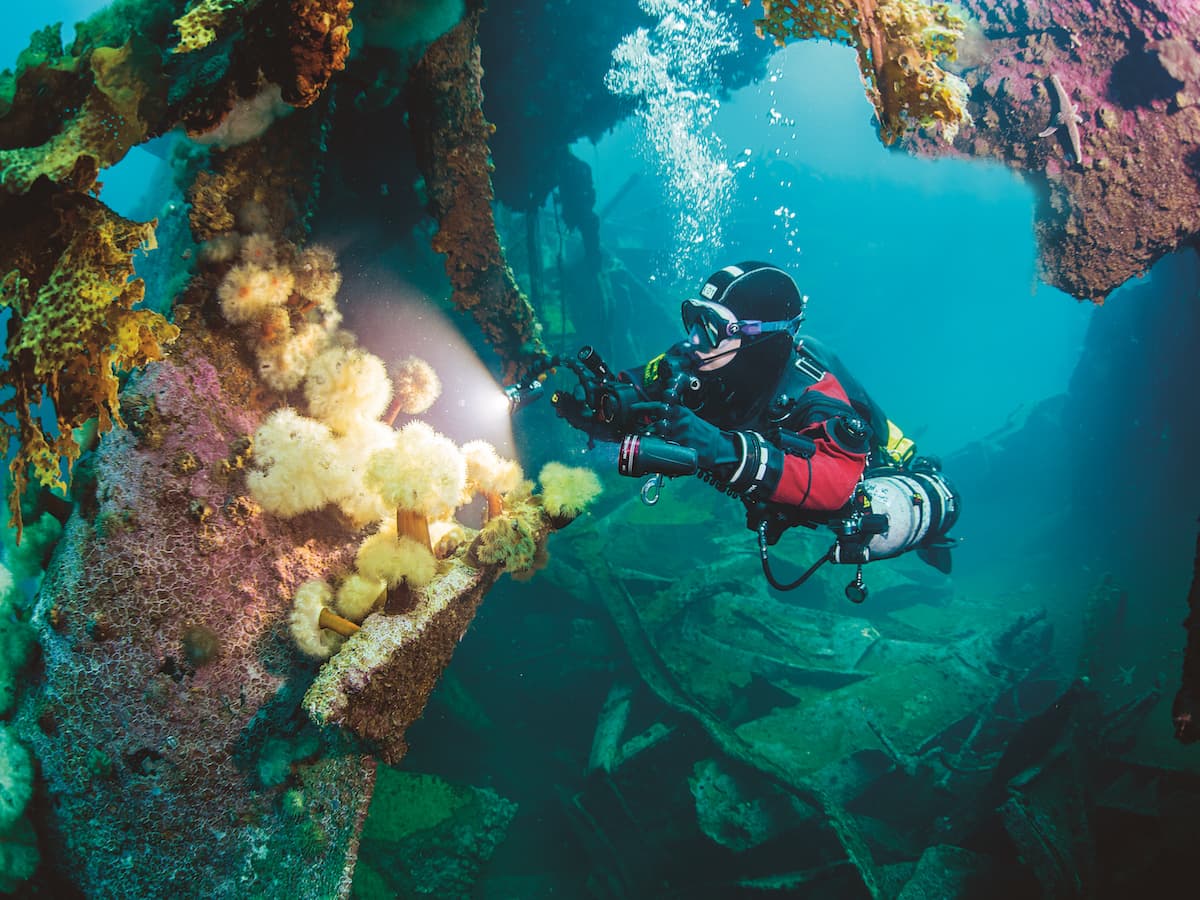
Diving Newfoundland’s Colourful Wrecks
The wrecks themselves convey a sort of intimacy. You might stumble across an antique LP record or even a sextant, as one of our teammates did a few years ago. Inside the wrecks, the telegraph and other artefacts are still intact, a testament to Canadians’ strict protection efforts. But for me, the exterior beauty is second to none. Every square inch of heavy plating is festooned with colorful life.
Puffs of plumose anemones frame the entrance to an intact Marconi room, where an operator made a call for help. Bulbous red lumpfish guard eggs in a ventilation shaft, and large cod swarm a massive anchor locker. Brass plates identify unfired deck guns, but parts of the ships bear wounds where torpedoes ripped them apart.
“Each year things are a little different. The icebergs mow a path through the debris in winter, and summer growth of marine life hides the scars once more.”
While giving a presentation to schoolchildren on the island, I thought the gymnasium seemed too large for the assembled kids. The island population is one-fifth of its former glory, and yet the room is filled with vibrating energy – there are not too many presentations like this on Bell Island. After our workshop, we chat with kids about their vision of the future. Although most will leave the island for work, some are discovering their sense of place.
A small boy walks up to us, and enthusiastically offers a simple statement that lets me know we have accomplished our work. “I didn’t know we were important. I didn’t know Bell Island mattered.”
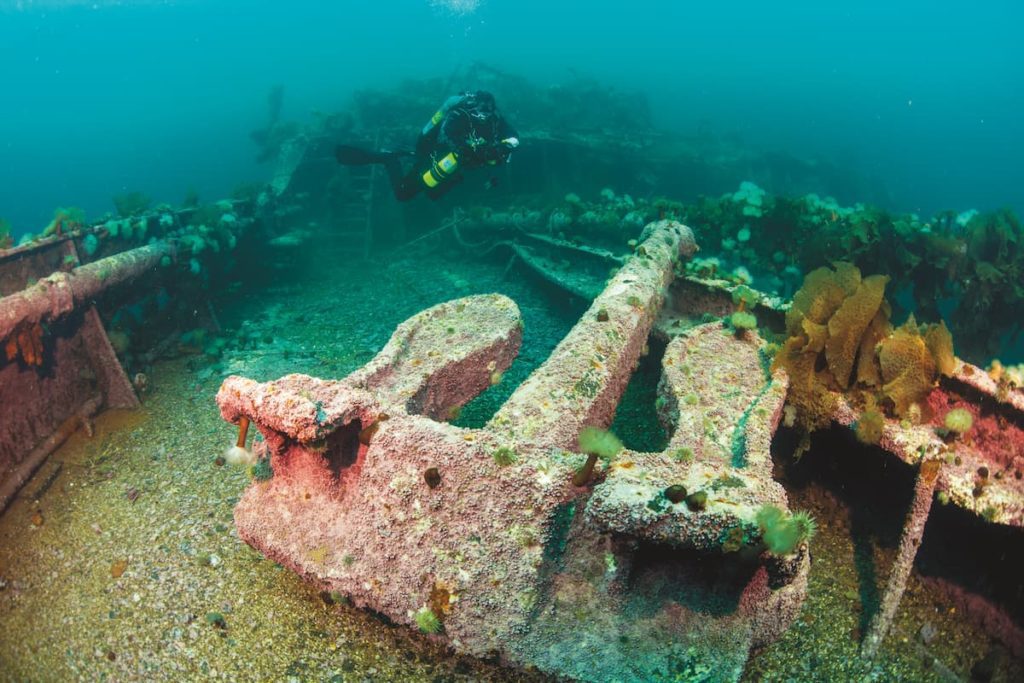
Embark on an Ocean Quest
Ocean Quest Adventure Resort co-ordinates all local diving activities. Certified cave divers are escorted into the mine, briefed, and supported by local safety staff. Landlubbers can enjoy a fascinating tour of the No. 2 Mine and Museum, or a hike through abandoned mine tunnels at the ‘Grebe’s Nest’. Ocean Quest offers packages, daily recreational, and full technical excursions to dive the World War Two wrecks, large enough to merit numerous visits. Advanced diving qualification is essential, but personal guides and instruction are also available.
No trip is complete without a Zodiac excursion to swim with wildlife such as humpback whales that feed in the region in the summer months. In late June and early July, a parade of icebergs drifts down the coast. Advanced divers comfortable with navigation, down currents, and free ascents may participate in this activity based from a RIB. Divers wear provided helmets and should carry a compass and surface marker buoy so they may ascend away from the ice face.
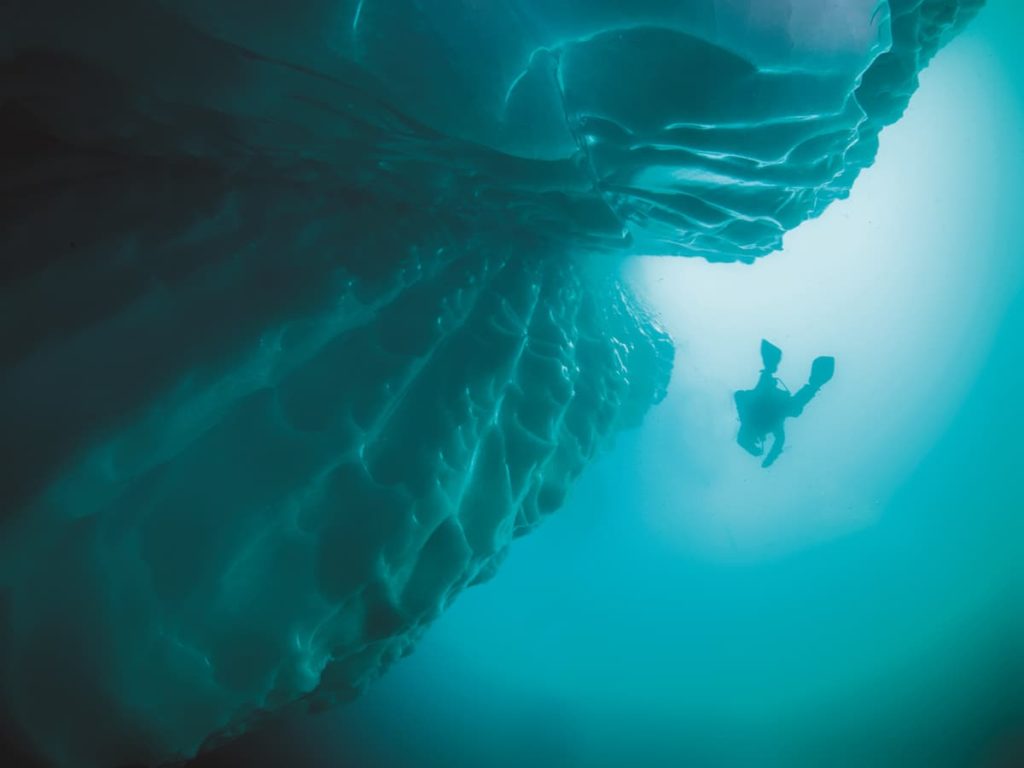
Diving Newfoundland – What you need to know
When to go – The diving season runs from June through September, with the best weather and wildlife opportunities in late June and early July. Special accommodations for groups can be made on off seasons.
Dive conditions – Shipwreck depths from 82ft-148ft with near-freezing temperatures on the bottom and up to 55°F on the surface. Wrecks are relatively sheltered from all but the worst weather.
Vessel – The Mermaid offers a large transom lift and ample warm, enclosed space with the best onboard soup you’ll find anywhere.
Operator – Ocean Quest Adventures
Newfoundland History Timeline
c. 3000 B.C. – Maritime Archaic Indians moved to the Island of Newfoundland.
1497 – John Cabot arrived in Newfoundland, claiming land as British colony.
1550 – Whaling stations established.
1819 – Mining begins on Bell Island.
1896 – Miners at Bell Island struck for two-cents an hour raise.
1899 – 27-foot-long dinosaur fossil with wings found in mine. It is photographed and discarded to prevent mine closure.
1941 – American troops arrived St John’s; construction of American naval base at Argentia began.
1942 – German submarine torpedoed ferry, SS Caribou, 127 passengers killed; German submarines sank ships at Bell Island; American naval ships Truxton and Pollux lost off St Lawrence with 189 officers and men lost.
1949 – Newfoundland became 10th province of Canada; Joseph Roberts Smallwood elected first premier of Newfoundland.
1966 – Bell Island Mine closed and flooded.
1985 – Titanic wreck found 400 miles east of Newfoundland at a depth of 13,000ft.
1992 – The Canadian government closed northern cod fishery.
1997 – Hibernia offshore drilling platform pumped first barrel of oil.
Bell Island
Few people know that Bell Island, Newfoundland, Canada was directly attacked during World War Two. In 1942, German U-boats twice raided the island in an attempt to disrupt the flow of high-grade iron ore from mines on the island. Germans knew that if they could stop the flow of ship building materials, even temporarily, then the Allied war efforts would be seriously affected. In two separate attacks, U-boats sunk the SS Saganaga and SS Lord Strathcona followed by the SS Rose Castle, Free French vessel PLM 27 and the loading wharf on Bell Island. Today, divers can plunge into history and dive on the wrecks that are referred to as the ‘Truk Lagoon of the North’.
Want to know more?
Visit Jill’s Guide to Newfoundland for more information.
